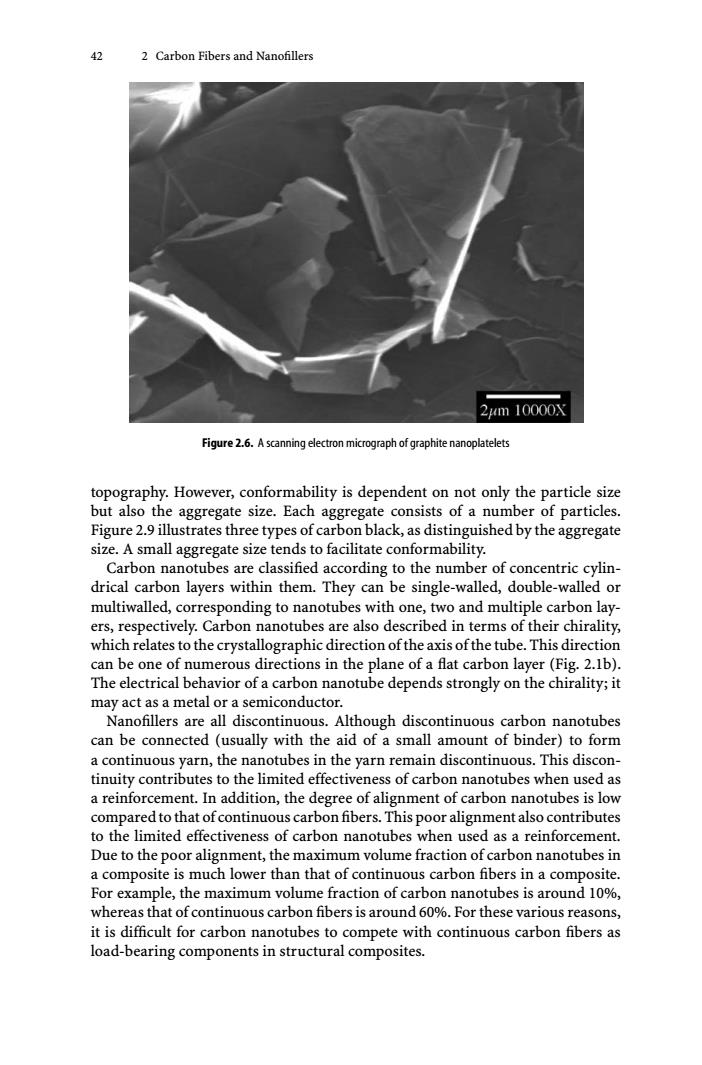正在加载图片...

42 2 Carbon Fibers and Nanofillers 2um10000X Figure 2.6.A scanning electron micrograph of graphite nanoplatelets topography.However,conformability is dependent on not only the particle size but also the aggregate size.Each aggregate consists of a number of particles. Figure 2.9 illustrates three types of carbon black,as distinguished by the aggregate size.A small aggregate size tends to facilitate conformability. Carbon nanotubes are classified according to the number of concentric cylin- drical carbon layers within them.They can be single-walled,double-walled or multiwalled,corresponding to nanotubes with one,two and multiple carbon lay- ers,respectively.Carbon nanotubes are also described in terms of their chirality, which relates to the crystallographic direction of the axis of the tube.This direction can be one of numerous directions in the plane of a flat carbon layer(Fig.2.1b). The electrical behavior of a carbon nanotube depends strongly on the chirality;it may act as a metal or a semiconductor. Nanofillers are all discontinuous.Although discontinuous carbon nanotubes can be connected (usually with the aid of a small amount of binder)to form a continuous yarn,the nanotubes in the yarn remain discontinuous.This discon- tinuity contributes to the limited effectiveness of carbon nanotubes when used as a reinforcement.In addition,the degree of alignment of carbon nanotubes is low compared to that of continuous carbon fibers.This poor alignment also contributes to the limited effectiveness of carbon nanotubes when used as a reinforcement. Due to the poor alignment,the maximum volume fraction of carbon nanotubes in a composite is much lower than that of continuous carbon fibers in a composite. For example,the maximum volume fraction of carbon nanotubes is around 10%, whereas that of continuous carbon fibers is around 60%.For these various reasons, it is difficult for carbon nanotubes to compete with continuous carbon fibers as load-bearing components in structural composites.42 2 Carbon Fibers and Nanofillers Figure 2.6. A scanning electron micrograph of graphite nanoplatelets topography. However, conformability is dependent on not only the particle size but also the aggregate size. Each aggregate consists of a number of particles. Figure 2.9 illustrates three types of carbon black, as distinguished by the aggregate size. A small aggregate size tends to facilitate conformability. Carbon nanotubes are classified according to the number of concentric cylindrical carbon layers within them. They can be single-walled, double-walled or multiwalled, corresponding to nanotubes with one, two and multiple carbon layers, respectively. Carbon nanotubes are also described in terms of their chirality, which relates to the crystallographic direction of the axis of the tube. This direction can be one of numerous directions in the plane of a flat carbon layer (Fig. 2.1b). The electrical behavior of a carbon nanotube depends strongly on the chirality; it may act as a metal or a semiconductor. Nanofillers are all discontinuous. Although discontinuous carbon nanotubes can be connected (usually with the aid of a small amount of binder) to form a continuous yarn, the nanotubes in the yarn remain discontinuous. This discontinuity contributes to the limited effectiveness of carbon nanotubes when used as a reinforcement. In addition, the degree of alignment of carbon nanotubes is low compared to that of continuous carbon fibers. This poor alignment also contributes to the limited effectiveness of carbon nanotubes when used as a reinforcement. Due to the poor alignment, the maximum volume fraction of carbon nanotubes in a composite is much lower than that of continuous carbon fibers in a composite. For example, the maximum volume fraction of carbon nanotubes is around 10%, whereas that of continuous carbon fibers is around 60%. For these various reasons, it is difficult for carbon nanotubes to compete with continuous carbon fibers as load-bearing components in structural composites